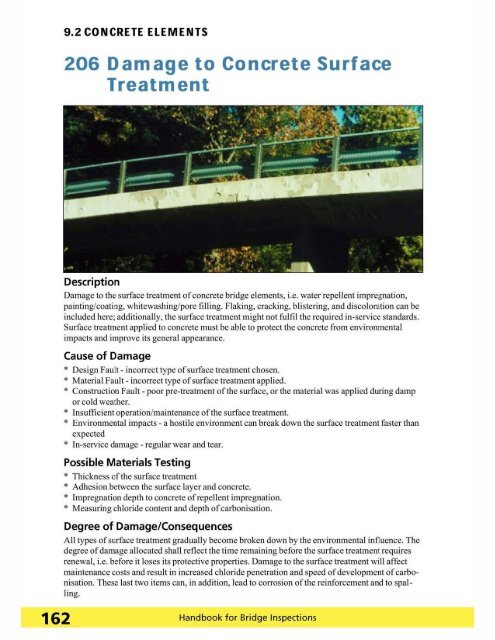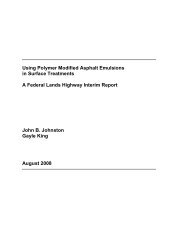Handbook for Bridge Inspections - TSP2
Handbook for Bridge Inspections - TSP2
Handbook for Bridge Inspections - TSP2
Create successful ePaper yourself
Turn your PDF publications into a flip-book with our unique Google optimized e-Paper software.
9.2 CONCRETE ELEMENTS<br />
206 Damage to Concrete Surface<br />
Treatment<br />
Descri ption<br />
Damage to the surface treatment of concrete bridge elements, i.c. water repellent impregnation,<br />
painting/coating, whitewashing/pore filling. Flaking, cracking, bli stering, and discoloration can be<br />
incl uded here; additionally, the surface treatment might not fu lftl lhe required in-service standards.<br />
Surface treatment applied to concrete must be able to protect the concrete from environmental<br />
impacts and improve its general appearance.<br />
Cause of Damage<br />
• Design Fault - incorrect type of surface treatment chosen.<br />
• Material Fault - incorrect type of surface treatment applied.<br />
• Construction Fault - poor pre-treatment of the surface, or the material was appl ied during damp<br />
or cold weather.<br />
• Insufficient operation/maintenance of the surface treatment.<br />
• Environmental impacts - a hosti le environment can break down the surface treatment faster than<br />
expected<br />
• In-service damage - regul ar wear and tear.<br />
Possible Materials Testing<br />
• Thickness of the surface treatment<br />
• Adhesion between the surface layer and concrete.<br />
• Impregnation depth to concrete of repellent impregnation.<br />
• Measuring chloride content and depth of carbonisation.<br />
Degree of Damage/Consequences<br />
All types of surface treatment gradually become broken down by the environmental influence. The<br />
degree of damage a ll ocated shall reflect the time remaining be<strong>for</strong>e the surface treatment requires<br />
renewal, i.e. be<strong>for</strong>e it loses its protective properties. Damage to the surface treatment wi ll affect<br />
maintenance costs and result in increased chl oride penetration and speed of development of carbonisation.<br />
These last two items can, in addition, lead to corrosion of the rein<strong>for</strong>cement and to spalling.<br />
162 <strong>Handbook</strong> <strong>for</strong> <strong>Bridge</strong> <strong>Inspections</strong>
















